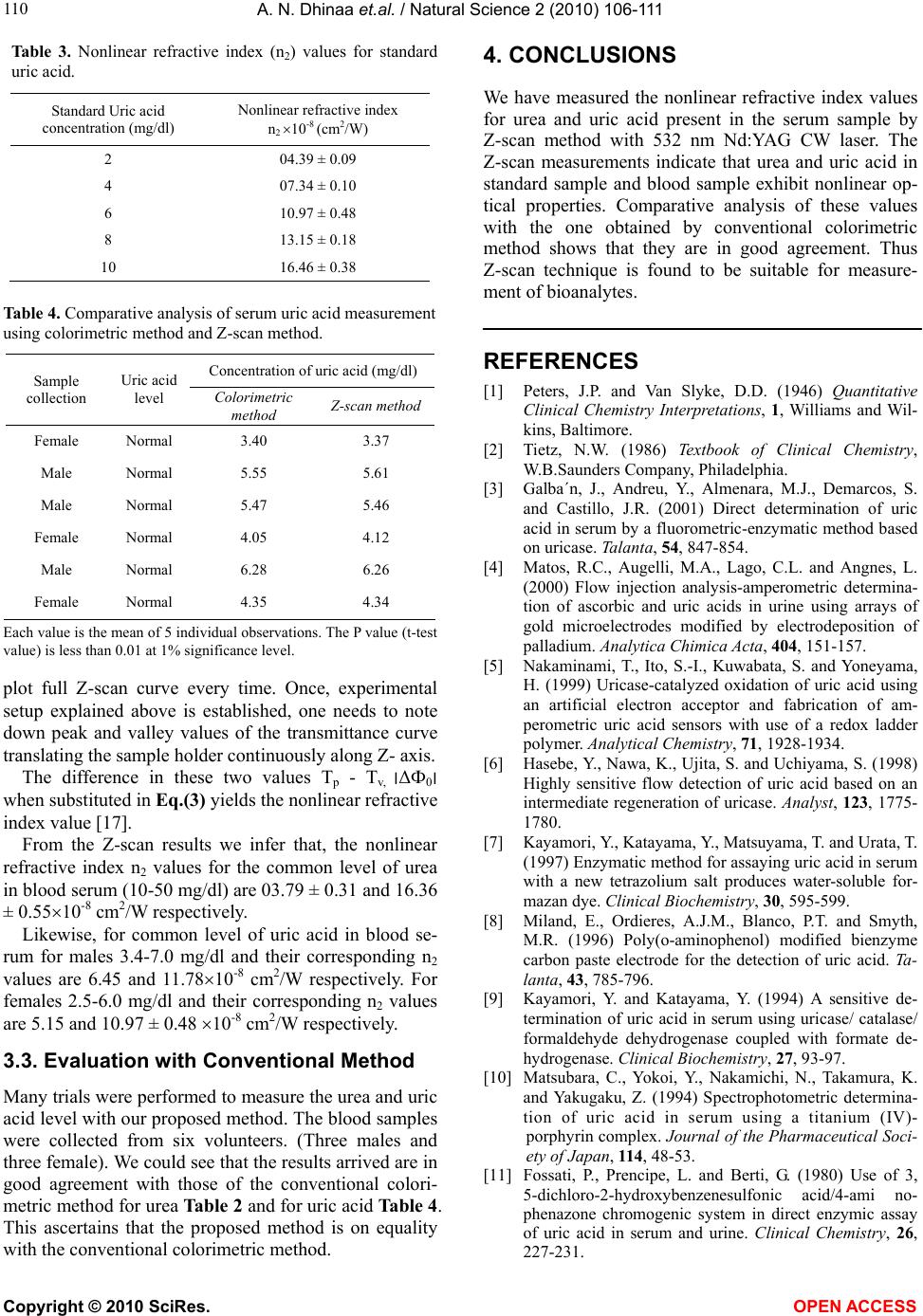
A. N. Dhinaa et.al. / Natural Science 2 (2010) 106-111
Copyright © 2010 SciRes. OPEN ACCESS
110
Table 3. Nonlinear refractive index (n2) values for standard
uric acid.
Standard Uric acid
concentration (mg/dl)
Nonlinear refractive index
n2 10-8 (cm2/W)
2 04.39 ± 0.09
4 07.34 ± 0.10
6 10.97 ± 0.48
8 13.15 ± 0.18
10 16.46 ± 0.38
Table 4. Comparative analysis of serum uric acid measurement
using colorimetric method and Z-scan method.
Concentration of uric acid (mg/dl)
Sample
collection
Uric acid
level Colorimetric
method Z-scan method
Female Normal 3.40 3.37
Male Normal 5.55 5.61
Male Normal 5.47 5.46
Female Normal 4.05 4.12
Male Normal 6.28 6.26
Female Normal 4.35 4.34
Each value is the mean of 5 individual observations. The P value (t-test
value) is less than 0.01 at 1% significance level.
plot full Z-scan curve every time. Once, experimental
setup explained above is established, one needs to note
down peak and valley values of the transmittance curve
translating the sample holder continuously along Z- axis.
The difference in these two values Tp - Tv, ׀ΔФ0׀
when substituted in Eq.( 3) yields the nonlinear refractive
index value [17].
From the Z-scan results we infer that, the nonlinear
refractive index n2 values for the common level of urea
in blood serum (10-50 mg/dl) are 03.79 ± 0.31 and 16.36
± 0.5510-8 cm2/W respectively.
Likewise, for common level of uric acid in blood se-
rum for males 3.4-7.0 mg/dl and their corresponding n2
values are 6.45 and 11.7810-8 cm2/W respectively. For
females 2.5-6.0 mg/dl and their corresponding n2 values
are 5.15 and 10.97 ± 0.48 10-8 cm2/W respectively.
3.3. Evaluation with Conventional Method
Many trials were performed to measure the urea and uric
acid level with our proposed method. The blood samples
were collected from six volunteers. (Three males and
three female). We could see that the results arrived are in
good agreement with those of the conventional colori-
metric method for urea Table 2 and for uric acid Table 4.
This ascertains that the proposed method is on equality
with the conventional colorimetric method.
4. CONCLUSIONS
We have measured the nonlinear refractive index values
for urea and uric acid present in the serum sample by
Z-scan method with 532 nm Nd:YAG CW laser. The
Z-scan measurements indicate that urea and uric acid in
standard sample and blood sample exhibit nonlinear op-
tical properties. Comparative analysis of these values
with the one obtained by conventional colorimetric
method shows that they are in good agreement. Thus
Z-scan technique is found to be suitable for measure-
ment of bioanalytes.
REFERENCES
[1] Peters, J.P. and Van Slyke, D.D. (1946) Quantitative
Clinical Chemistry Interpretations, 1, Williams and Wil-
kins, Baltimore.
[2] Tietz, N.W. (1986) Textbook of Clinical Chemistry,
W.B.Saunders Company, Philadelphia.
[3] Galba´n, J., Andreu, Y., Almenara, M.J., Demarcos, S.
and Castillo, J.R. (2001) Direct determination of uric
acid in serum by a fluorometric-enzymatic method based
on uricase. Talanta, 54, 847-854.
[4] Matos, R.C., Augelli, M.A., Lago, C.L. and Angnes, L.
(2000) Flow injection analysis-amperometric determina-
tion of ascorbic and uric acids in urine using arrays of
gold microelectrodes modified by electrodeposition of
palladium. Analytica Chimica Acta, 404, 151-157.
[5] Nakaminami, T., Ito, S.-I., Kuwabata, S. and Yoneyama,
H. (1999) Uricase-catalyzed oxidation of uric acid using
an artificial electron acceptor and fabrication of am-
perometric uric acid sensors with use of a redox ladder
polymer. Analytical Chemistry, 71, 1928-1934.
[6] Hasebe, Y., Nawa, K., Ujita, S. and Uchiyama, S. (1998)
Highly sensitive flow detection of uric acid based on an
intermediate regeneration of uricase. Analyst, 123, 1775-
1780.
[7] Kayamori, Y., Katayama, Y., Matsuyama, T. and Urata, T.
(1997) Enzymatic method for assaying uric acid in serum
with a new tetrazolium salt produces water-soluble for-
mazan dye. Clinical Biochemistry, 30, 595-599.
[8] Miland, E., Ordieres, A.J.M., Blanco, P.T. and Smyth,
M.R. (1996) Poly(o-aminophenol) modified bienzyme
carbon paste electrode for the detection of uric acid. Ta-
lanta, 43, 785-796.
[9] Kayamori, Y. and Katayama, Y. (1994) A sensitive de-
termination of uric acid in serum using uricase/ catalase/
formaldehyde dehydrogenase coupled with formate de-
hydrogenase. Clinical Biochemistry, 27, 93-97.
[10] Matsubara, C., Yokoi, Y., Nakamichi, N., Takamura, K.
and Yakugaku, Z. (1994) Spectrophotometric determina-
tion of uric acid in serum using a titanium (IV)-
porphyrin complex. Journal of the Pharmaceutical Soci-
ety of Japan, 114, 48-53.
[11] Fossati, P., Prencipe, L. and Berti, G. (1980) Use of 3,
5-dichloro-2-hydroxybenzenesulfonic acid/4-ami no-
phenazone chromogenic system in direct enzymic assay
of uric acid in serum and urine. Clinical Chemistry, 26,
227-231.